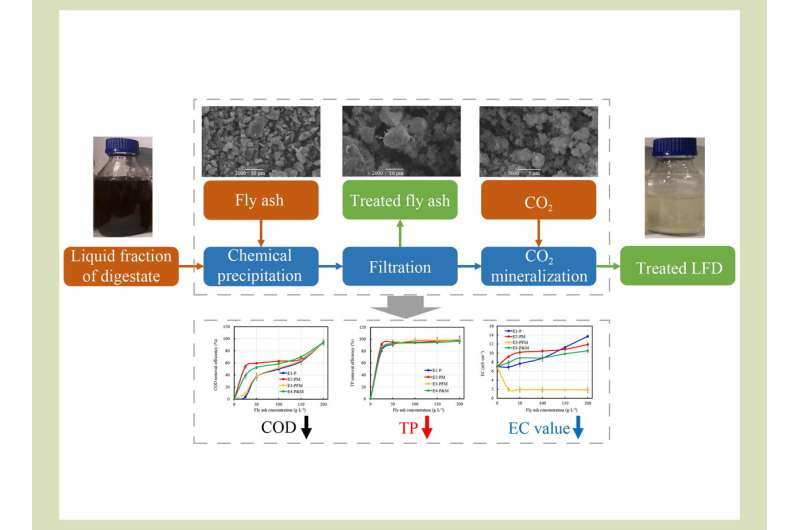This article has been reviewed according to Science X's editorial process and policies. Editors have highlighted the following attributes while ensuring the content's credibility:
fact-checked
proofread
Scientifically, efficiently and cost-effectively treating wastewater generated from anaerobic digestion

The resource utilization of waste is important in the construction of an ecological civilization. Agricultural waste contains rich renewable resources and has high potential value in fertilization and energy conversion. Anaerobic digestion technology is promising for treating agricultural waste.
Anaerobic digestion refers to the way in which organic matter is decomposed into CH4, CO2, H2O and H2S by facultative bacteria and anaerobic bacteria under anaerobic conditions, which can transform solid organic matter into soluble organic matter. Not only does it have the advantages of stable processing and low operational cost, the biogas produced can also be used as clean biomass energy, reducing air pollution.
However, the digestate (LFD) discharged from the anaerobic device contains high chemical oxygen demand (COD) and phosphate concentration. If discharged directly without proper treatment, it may pose risks, such as water eutrophication to the environment. In addition, because of its high nutrient content, LFD can be used as organic fertilizer to reduce the application of mineral fertilizer and increase crop yield. However, its direct application as fertilizer is always limited by the growing season and the available arable land area, and the long-term application of LFD in farmland can lead to the loss of nutrients in the soil. The accumulated harmful metals in LFD pose a risk of migration to plants.
Various treatment technologies for LFD have been reported, including chemical precipitation, flocculation-coagulation, air stripping, membrane separation, ion exchange, adsorption, evaporation, chemical oxidation or deep oxidation, and microalgae cultivation. Chemical precipitation is a pretreatment method widely used in wastewater treatment, aiming to remove phosphates, heavy metals and organic pollutants. The principle is to form insoluble precipitates through the reaction of metal and non-metal ions, and then remove them by filtration or sedimentation.
Compared with other LFD treatment technologies, chemical precipitation has the advantages of simple configuration and low investment cost. However, it also faces the problem of high operating costs due to the consumption of chemicals in the process. In order to promote the large-scale application of this technology, it is necessary to develop efficient and low-cost precipitants and new treatment processes.
Coal fly ash, as a by-product of coal-fired power plants, has a particularly large production worldwide. The global production of coal fly ash was about 11 Gt in 2019, 53% of which was used for building materials, and the rest was sent to landfills. It not only takes up land resources, but also increases treatment costs due to the continuous reduction of the area available for landfill. It is crucial to develop new uses for fly ash.
Due to the high alkalinity and high metal content of fly ash, it may be used for the chemical precipitation of LFD, but there are few reports on this aspect. In addition, chemical precipitation based on fly ash LFD can simultaneously remove several organic and inorganic pollutants, but its use still has the problem of alkaline minerals (such as OH–, Ca2+ and Mg2+) and heavy metals in fly ash dissolving into LFD, which will increase the cost and environmental risk of wastewater post-treatment.
To address these issues, the authors of a paper published in Frontiers of Agricultural Science and Engineering studied a new method, namely, chemical precipitation based on fly ash and CO2 mineralization, for the efficient removal of pollutants in LFD. This study determined the technical feasibility of this process, explored the potential mechanism of the reaction, studied the removal rate of pH, electrical conductivity (EC), total phosphorus (TP), COD, and heavy metals during the treatment process of this process, and analyzed the physicochemical properties of fly ash and LFD before and after the experiment to determine the reaction mechanism.
The study found that the pH and EC of LFD treated increased with the increase of fly ash concentration, because the metal oxides or hydroxides in fly ash dissolved into LFD, increasing the concentration of OH– and metal ions in LFD. The pH and EC of LFD after fly ash-based chemical precipitation decreased after CO2 bubbling treatment. In the experiment, the removal efficiency of COD increased with the increase of fly ash concentration, reaching a maximum of 93.8%.
The removal of TP by fly ash-based chemical precipitation was even more significant, reaching 80% even at low concentrations of fly ash, and continuing to increase to 98% with the increase of fly ash concentration. Leaching experiments were conducted on the treated and untreated LFD samples, and it was found that the concentration of toxic ions released from the treated samples was much lower than that of the untreated samples.
In this study, fly ash was used as a chemical precipitant to remove COD and TP in LFD with good results. The CO2 bubbling after the fly ash-based chemical precipitation helps to neutralize the pH of LFD, reduce EC, and remove some toxic ions. The treated LFD can meet the requirements for irrigation water.
The theoretical significance of this study is that it explores a low-cost and efficient method for treating anaerobic digestate, providing a new idea for the resource utilization of agricultural waste. The practical significance is that this method can effectively remove pollutants in anaerobic digestate, reduce negative impacts on the environment, and provide high-purity calcium carbonate products, with potential economic and environmental benefits.
More information: Zhengxin Fei et al, Efficient contaminant removal from liquid digestate of pig manure by chemical precipitation and CO2 mineralization using alkaline ash, Frontiers of Agricultural Science and Engineering (2023). DOI: 10.15302/J-FASE-2023480
Provided by Frontiers Journals





















